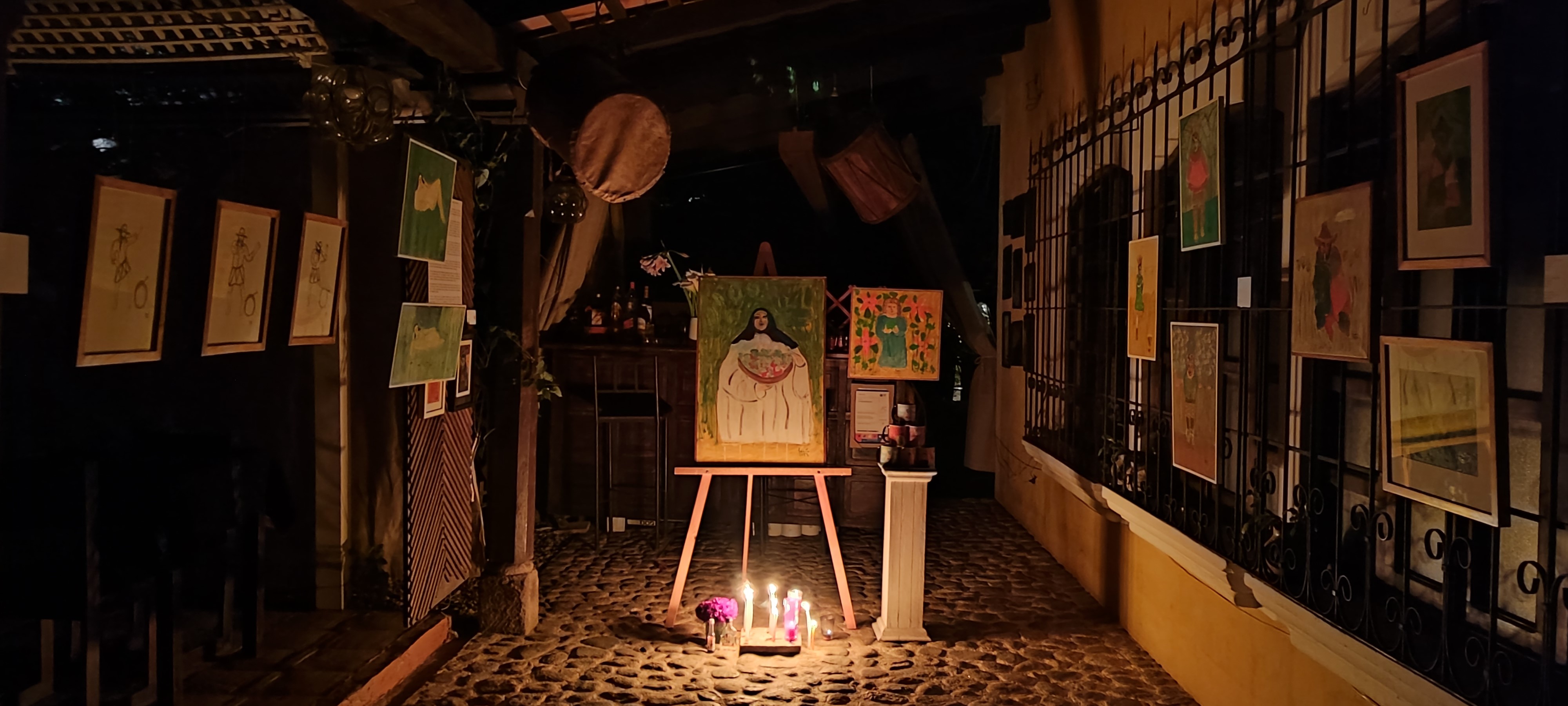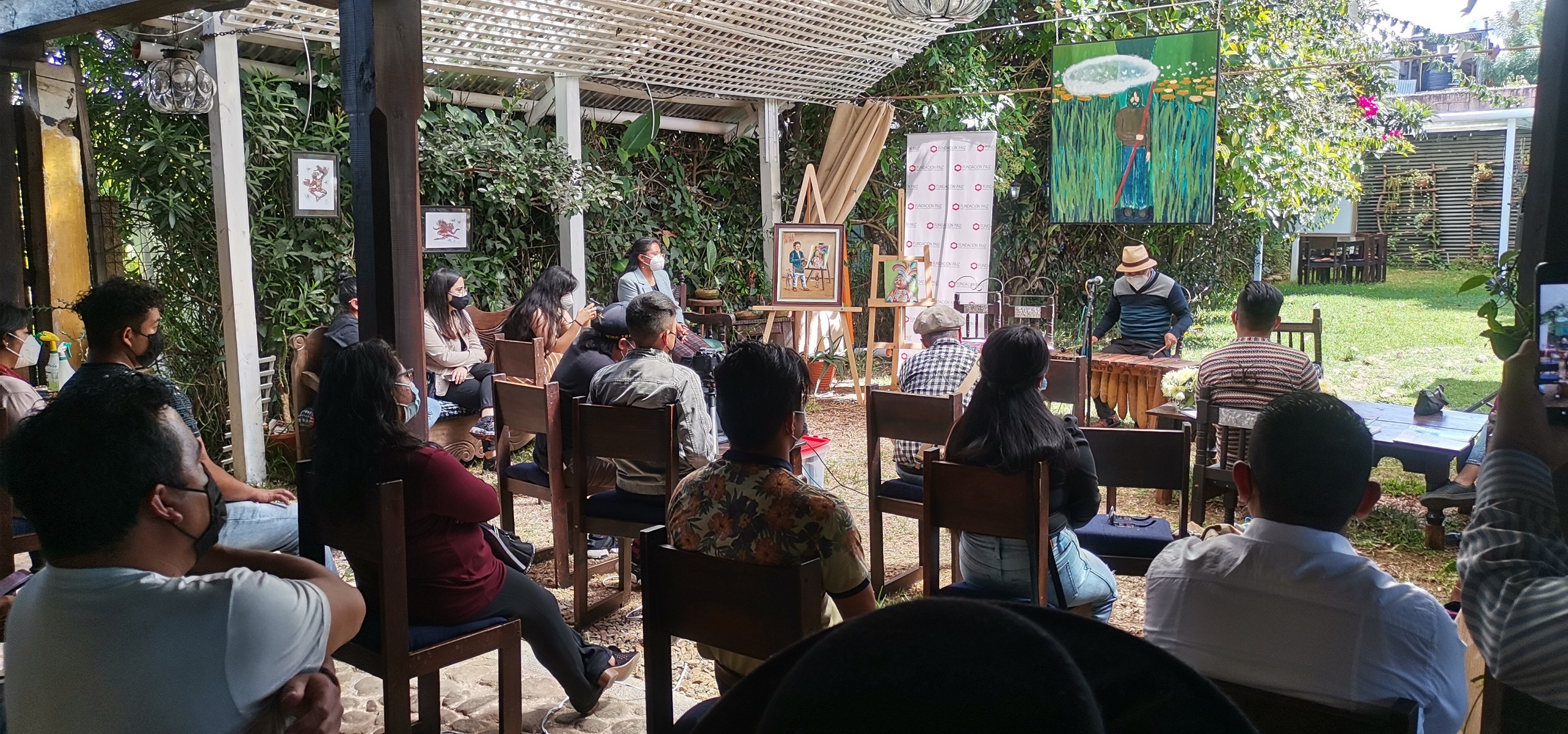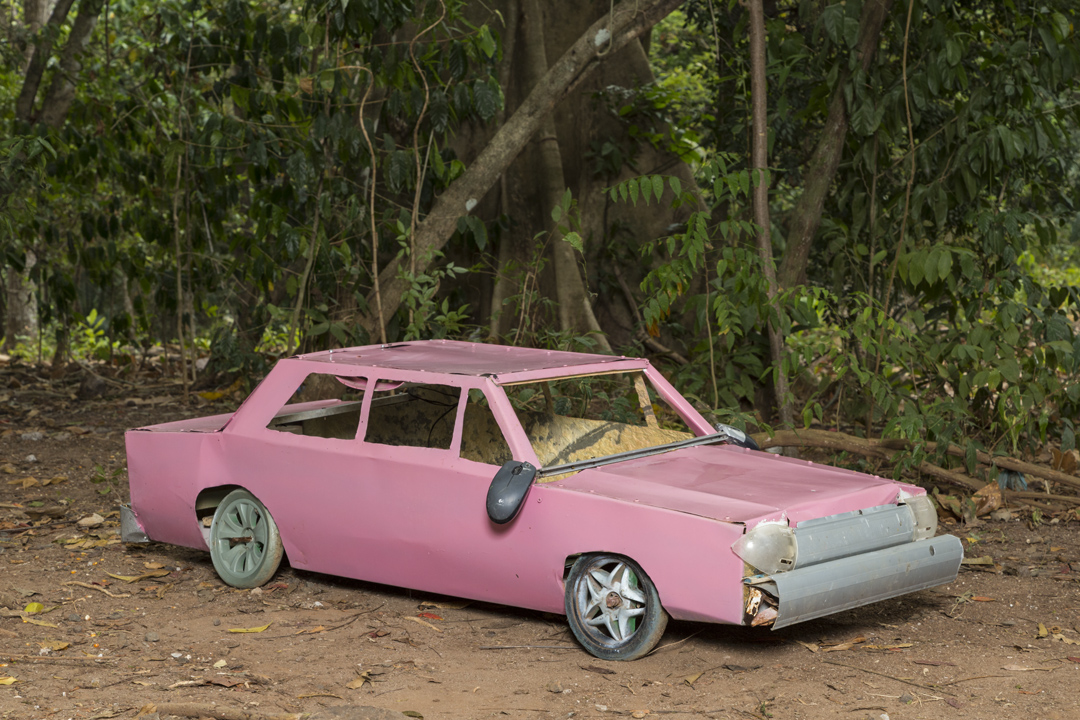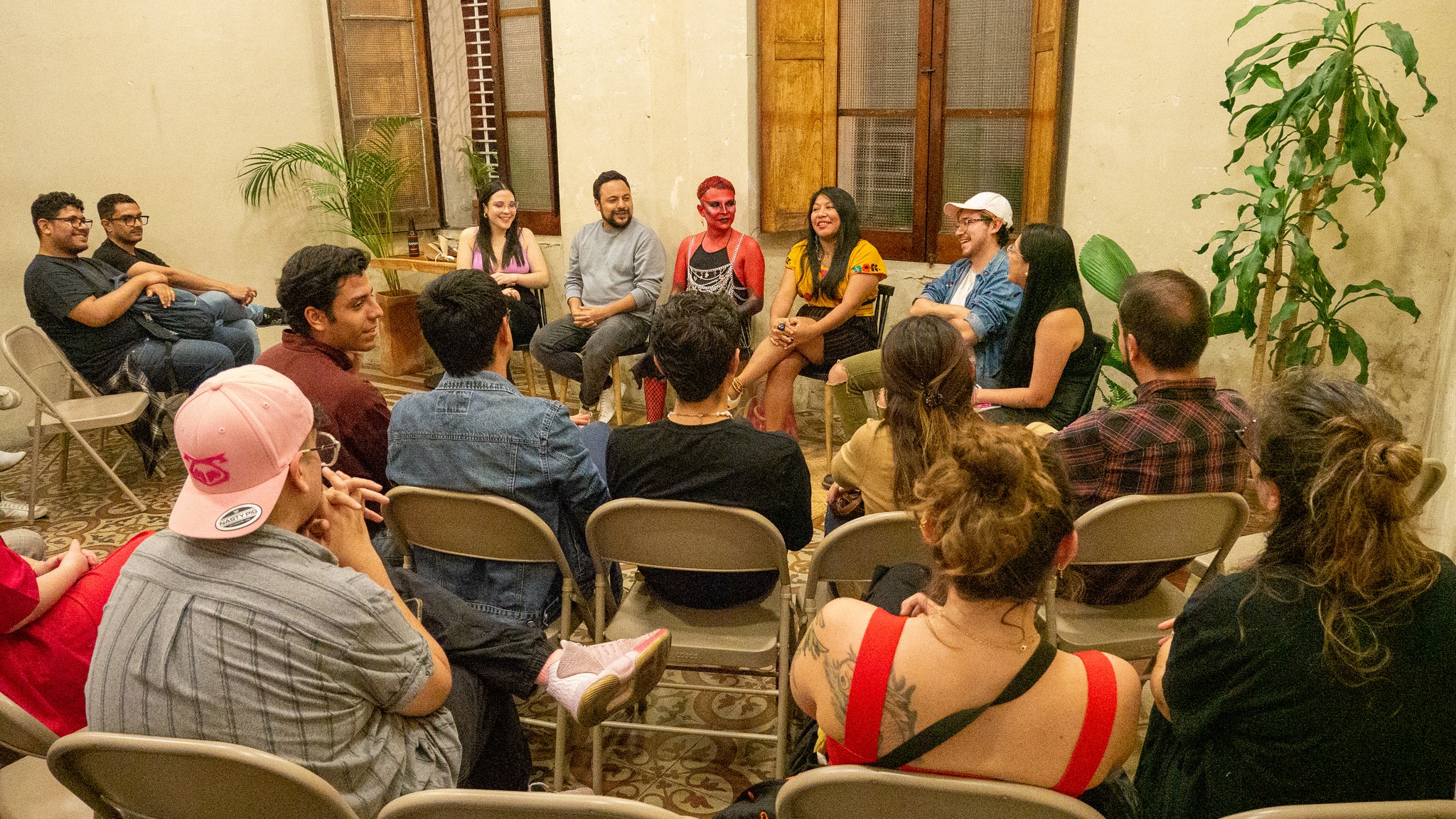Maya Juracán: Anny, what do you understand by art and education?
Educating through Memory, Care, and the Artistic Thought of Indigenous Peoples
Teaching to Deconstruct Ourselves
Anny Ventura Puac: This is a quite complex question. First, because I grew up under the standards of Western education, purely white and very religious, and therefore, from these conceptions it is very difficult to define yourself. I could tell you that education are norms, guidelines that teach you to think in a way that is perhaps very heteronormative, patriarchal, and all these political postulates; they do not teach us to deconstruct ourselves. And art, in the education I received, was a trade that was reduced to a person who paints, sculpts, or works with some material like clay, and that was it, that was the conception of what is art and what is education.
Now, in my current moment, for me art is a form of political expression, it is a political statement depending on the territory where you are and the profession you practice. For example, perhaps our grandmothers and grandfathers did not define art as such, but they did have artistic trades, such as the tzukojom, who is the person who plays the marimba of tecomates, or the aj' kem, which is an artistic trade of weaving the treatment of threads. So, for me, art is everything that the human being has developed, from its beginnings and origins, as a trade; beyond what the academy or the globalized world has told you that is “art.”
MJ: Diego, what role does education play in your work?
Diego Ventura Puac-Coyoy: For me, it is important to have full distinctions between the implications of education and formation. Mainly, formation is something that we receive every day in our home, very simple things like care and treatment towards other people, towards things, our daily interactions. I think we are in a moment in which it is important to recover certain things from the past in terms of education and formation, because the constant professionalization and academicism have led us to forget to take care of other people, mainly in the context of visual arts and research based on visual arts.
As a curator of contemporary art, I am formally devoted to the recovery of historical memory and the construction of community memory. Oftentimes, because of pressures or because of the academic horizon we have, which tends to be Eurocentric and aspirational, we think that the results of our work and our research have to be presented outside our community to be validated, and this has been a mistake in the near past because it has not allowed us to give continuity to the construction of community memory. What we are discovering, reinterpreting, revising, rediscovering, or recognizing, are things that we had forgotten and that are presented in spaces that are alien to our reality and our daily life, and this creates an interruption between the processes of reconstruction of community memory.
That is why we have lost much of what we understand as identity and of the daily practice of the community fabric, of how we treat others, and above all, of how we take care of our context and other people, of what surrounds us, of nature, which is one with us. This is something very important, not only in my practice as a contemporary art professional, but also in my practice as an Aj’qi´j, or spiritual guide in K’iche’ Mayan.

"13 obras y Santos en paz" exhibition by Rodolfo de León, espacio /C.
Courtesy: Diego Ventura.
MJ: What does an Aj’qi’j do?
AVP: Well, Aj’qi´j is a person, AJ’ is the suffix to determine the profession in our mother tongue, which is K’iche’, and Qi´j is about the rotation of the sun, the counting of the sun, so we are counters of time. We handle the trade of mathematics as a science, because we have to count time, not in the ordinary Gregorian calendar, which is the one used in the Western world, but we handle the accounting of time from our ancestors, the agricultural cycles, the cycles of the sun and the moon. But beyond counting time, my job is to work with fire, with the natural elements: fire, water, earth, according to the bodies of the people we serve. In itself, our trade is a service to the community, to the people who know us. We could say that still in many Indigenous communities, the profession of a psychologist is not understood, and, therefore, many times it is up to us to practice this profession of the science of mental health as well, as to help people. We specialize in different things, for instance, we may specialize in being healers. This also includes the midwives, the fortunetellers who work with the tzite’, that is to say, Aj’qi´j, which is a word that encompasses all the professions that have to do with spirituality, and they might not have a scientific explanation in today's world.

En la cumbre alta del campanario acompañada del UKAB' AJ KAM en el proceso del baile del tzijolaj.
Cortesía: Anny Ventura Puac.
MJ: How is artistic thinking constructed from the perspective of the native peoples?
DVPC: Mainly, art for us is a situation that we use, because it is something that permanently crosses our understanding. For example, we are used to the fact that our first approaches to form and color are our mothers’ huipiles: since we are carried on their back or chest, we grow up seeing colors, shapes, and textures of textiles. Likewise, music, the spoken word, the written word, are something that lives within us. Probably in our understanding as a community, the museum, the theater or the gallery do not make any sense because they are completely alien to us; we occupy the public space for our artistic manifestations, which are also intimately ritualistic, because they are part of our spiritual practice and our daily life: what we see, what we smell, what we eat, how we eat it, how we harvest it, how we sow it and how we understand it
One of the most tangible situations in which art crosses us is when it is time to do sowing or tapisca (harvest corn): there is always traditional music playing. Music is very present and I think it is the easiest way of dispersal. You see, in just about every store, fruit sale, or bakery, we can always hear torito dance music, Mexican dance music, or snake dance music, either on recordings or live broadcasts, and people love it, they love to hear that they get greeted on the broadcasts, because it is part of our community fabric. So, our understanding of the arts, of contemporary art, of poetry, literature, or music, is a bit off from academicism and whiteness.

Discussion group on knowledge of the K'iche people, as part of the mediation program of the exhibition "Antes de ser ya éramos." Collection of the Fondo Ventura Puac-Coyoy, espacio/C, and Fundación Paiz. espacio/C, Chichicastenango. Curated and mediated by Diego Ventura and Maya Juracán.
Courtesy: Diego Ventura.
Building a Communal Memory
MJ: Anny, what is the importance of historical memory in your work, both as an Aj’qi´j, as a political scientist, and in your work as a curator and art collector in your community?
AVP: For me, it is very important, because we are seeing new generations who are having another conception of life. When you have a different understanding of life, politics, memory as such, and art serve us as a political statement. First, to make this historical journey and show the older generations that artistic trades have always existed, but since work is conceived from the capitalist logic, many of the older people, 60 years old and older, consider that artistic work is a waste of time or that it will not generate any economic income for their children.
So, it is useful for us so that people who did not have access to these records can see that what young people are doing is not bad, and to break the logic and dynamics of thinking that we, as K’iche’ people, only have the tradition of accumulating capital or doing forced labor, or that we only have the right to be in the fields because that is all we know how to do, or because maybe, as women, marriage id our only way out, and then the house and then the children. So, I can tell you that this has helped us, precisely so that those who have not cultivated or have no memory of the old trades can take them up again and give a boost to their sons, their daughters, their relatives, their friends, or so that these very people in my community can see that they have every right, because their ancestors went before them, and they have every right to think differently and to combine their economic trade with a passion, with an art practice or expression that can really help them to understand who they are and how they see themselves.

En espacio C, entrevista con Génesis Tuyuc y Frisly Soberanis, de las diásporas migrantes.
Cortesía: Anny Ventura Puac.
MJ: What are some of the challenges presented by the contemporary cultural scene for a K’iche’ Mayan curator?
DVPC: Presently, I have noticed a tendency to turn the gaze toward the artistic practices of Native peoples, a bit like a fashionable topic. So, many times, curators who are not part of our communities or who have not had the required proximity, offer interpretations and provide spaces of certain forms of power to discourses that perhaps show or give an understanding that we, as indigenous peoples, are cultural subjects, but they don’t portray us as active political subjects, but merely as cultural samples. And this comes from the practice, or the long-standing idea stemming from the modernism of the Latin American states, of promoting the indigenous peoples, the archaeological sites, and our culture as tourist attractions or as exotic things, but never as sciences or knowledge that have a practical use in the life of the people, that assure them a good living, food sovereignty, and territorial autonomy. We are simply a folkloric stamp, and that is very dangerous.
We see it in museums across South America, North America, Mexico, Canada, Europe, in other latitudes of the world. Perhaps if the curatorial practice in those institutions could be conceived horizontally, the curators who have these positions of power could see the way to work with allies or curators who come from indigenous peoples. This is not necessarily a complaint, maybe it is simply an observation of how to work horizontally and caring for the people. We have realized that many artistic and cultural organizations—not only from the hegemonic institutions but also alternative or independent ones—despite having a discourse of equity, tolerance, respect, and care, continue to step on people with vertical structures or organizational charts. For us, as cultural agents from native peoples, this is somehow violent because we are required to have solvency, to be horizontal in our dealings with other people, but those who require it of us do not comply. So, this should be something important and integral to artistic practices, and this is one of the great challenges we have to face, because if we express the needs or experiences of our communities (such as the problems with the lands, food, the violation of our territorial and bodily autonomies), then we are accused of being resentful or other such types of discourses that have been largely polarizing in the modern history of our nations.
MJ: How can we teach about self-management in order to have social freedoms and to be able to name our activism from art, from curatorship?
DVPC: I think self-management is the future of the visual arts in hostile spaces or nations like Latin America. We have realized, in the specific case of Guatemala and other countries, that culture exists as a tourist attraction, as a country-brand, but there is no real interest. Of course, we don’t expect things from the State either, because a weakened and illegitimate State like the one we live in, is not going to give us the tools we need.
Self-management implies not only autonomy of concept, but also economic autonomy to be able to carry out our projects, to be able to talk about the issues that concern us and affect us, and also to set foot on the stage and talk about what is happening to us, about who is doing what to us, and that is very important for us. From the hegemonic or traditional institutions, there is usually a script we have to follow to be able to fit in with the political correctness or the sponsoring program or the patronage or the museum or the research; but from self-management, everything tends to be more frontal and we can talk about things, not in a violent way but in a direct way, and that can give us the possibility of threading discourses and talk about more or less urgent issues for us for as long as we want.
A Formative Practice
MJ: Where does your knowledge to become a curator come from? What were your struggles within this process? And how would you like education to be passed on to the younger generations of artists and curators?
DVPC: I acquired knowledge in my community and my family's practice. Essentially, it has been a daily training exercise, more than an education. I grew up seeing how my father and my grandparents not only knew how to work the land, but they could also do repairs in the house, they had a business and they had a profession. This is something that the specialization of work and modernity has taken away from us, because if one has a degree at the undergraduate or graduate level, it is assumed that one in this logic can no longer cook or till the land, or cannot do a myriad of things. Within my community, it is not uncommon for a university graduate to have parallel businesses or trades, and I believe that from this experience, I have been able to acquire knowledge and professional experience as a curator of contemporary art and as a researcher within my community, as well as outside of it.
I belong to two communities that are part of the same Mayan K’iche’ nation: I live in Chichicastenango and I also lived in Quetzaltenango, where I received all my formal elementary education. For us, the processes of ladinization and westernization were quite tough, because the native person or the indigenous person of Quetzaltenango is a westernized indigenous person, who completely lost their language and many expressions of the ancient culture that still exist in Chichicastenango.
However, having gone through these westernizing processes, granted me access to other spaces in Guatemala City. There I worked in an art gallery, in an art foundation, and I also witnessed firsthand certain dynamics that shouldn’t be replicable in our practice. Because they have a very Eurocentric understanding of art in those institutions, which of course diminishes the expressions of other artists or makers who aren’t exactly people that live in urban areas. And this is very relevant because the artistic expressions, discourses, and experiences of those who make art in urban areas will never be the same as that of those who make art and live in areas known as rural—or what we would understand as centers and peripheries.
However, I have witnessed other work dynamics, for example at the Bienal en Resistencia, where we have seen how cultural agents who are not part of the hegemonic contemporary circuit and have very powerful things to say because they are discourses that go through their bodies, but institutions often diminish them because they are not part of their reality or their truths or what they have to face on a daily basis. So, much of what I learned in the city was how not to treat people and how not to make or manage art: because they do not care for others and do not respect them, nor do they show a legitimate interest in the knowledge and words they have to say.
MJ: You are both devoted to curating and collecting indigenous art in your community; what future would you like to see for this collection and the work you do at espacio/C?
AVP: From the beginning, our intention was—and continues to be—to educate. But not in the line of imposing but from our conception as indigenous art, to educate through different feelings, from observation, from orality, and then people can also see that art is perhaps not the same as a craft. And also the fact of being in a purely K’iche’ territory, for us this collection is of utmost importance, because in the past, much of the current indigenous art is in kaxlan territories (white territories), so having this space, this collection, circulating these political as well as artistic statements is of utmost importance. There is evidence that our K’iche’ people were not only warriors and traders, there were also artistic crafts, which is what we are trying to make known again, so that we can better appreciate what we do and what we have.

Presentando a Espacio C en el encuentro Back To The Land.
Cortesía: Anny Ventura Puac.
MJ: What do you hope for the artistic education of the new generations?
DVPC: I would like for art to stop being seen as a mainly romantic or spiritual discipline. I would like artistic education, both at the high school level, which is the National School of Plastic Arts (ENAP), or the regional schools and the higher schools, such as the Superior School of Art and other private universities, to provide training not only in the technical aspects but also in the historical aspects and the critical awareness of individuals, so that they can be aware of how they are exerting their artistic career and from where.

